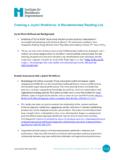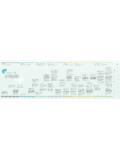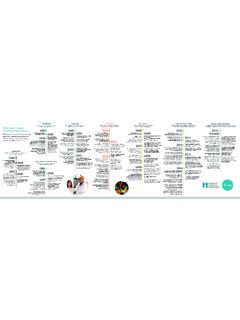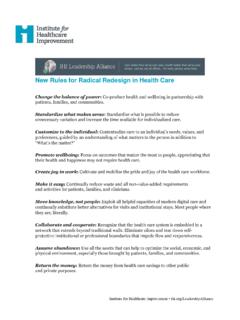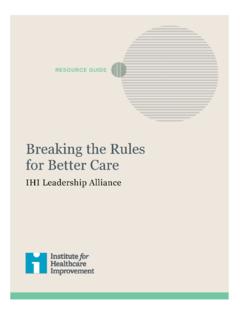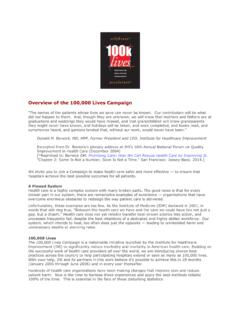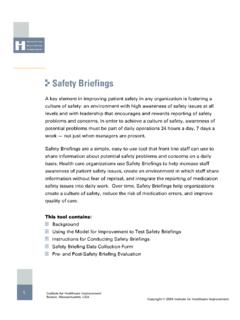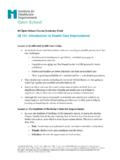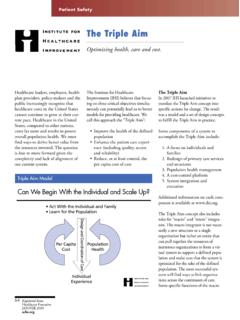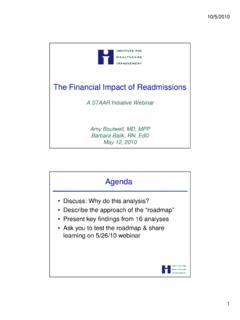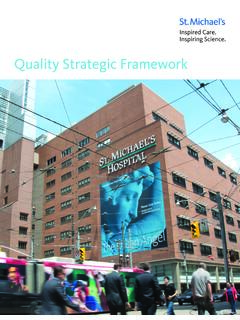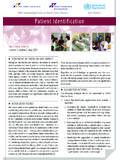Transcription of Open School IHI Open School Online Courses: …
1 open School IHI open School Online Courses: Curriculum Overview Improvement Capability .. 3. QI 101: Introduction to Health Care Improvement .. 3. QI 102: How to Improve with the Model for Improvement .. 4. QI 103: Testing and Measuring Changes with PDSA Cycles .. 5. QI 104: Interpreting Data: Run Charts, Control Charts, and other Measurement Tools .. 6. QI 105: Leading Quality Improvement .. 7. QI 201: Planning for Spread: From Local Improvements to System-Wide 8. QI 202: Achieving Breakthrough Quality, Access, and Affordability .. 9. QI 301: Guide to the IHI open School Quality Improvement 10. Patient Safety .. 11. PS 101: Introduction to Patient Safety .. 11. PS 102: From Error to Harm .. 12. PS 103: Human Factors and 13. PS 104: Teamwork and Communication in a Culture of Safety.
2 14. PS 105: Responding to Adverse Events .. 15. PS 201: Root Cause and Systems Analysis .. 16. PS 202: Building a Culture of Safety .. 17. PS 203: Partnering to Heal: Teaming Up Against Healthcare-Associated Infections .. 18. PS 204: Preventing Pressure Ulcers .. 19. Leadership .. 20. L 101: Introduction to Health Care 20. Person- and Family-Centered 21. PFC 101: Introduction to Person- and Family-Centered 21. PFC 102: Key Dimensions of Patient- and Family-Centered Care .. 22. PFC 103: Incorporating Mindfulness into Clinical 23. PFC 201: A Guide to Shadowing: Seeing Care through the Eyes of Patients and Families .. 25. PFC 202: Having the Conversation: Basic Skills for Conversations about End-of-Life 26. Triple Aim for Populations .. 27. TA 101: Introduction to the Triple Aim for Populations.
3 27. TA 102: Improving Health Equity .. 28. TA 103: Quality, Cost, and Value in Health Care .. 29. Graduate Medical Education .. 30. GME 201: Why Engage Trainees in Quality and Safety? .. 30. GME 202: A Guide to the Clinical Learning Environment Review (CLER) Program .. 31. GME 203: The Faculty Role: Understanding & Modeling Fundamentals of Quality & Safety .. 32. GME 204: The Role of Didactic Learning in Quality Improvement .. 33. GME 205: A Roadmap for Facilitating Experiential Learning in Quality Improvement .. 34. GME 206: Aligning Graduate Medical Education with Organizational Quality & Safety Goals . 35. GME 207: Faculty Advisor Guide to the IHI open School Quality Improvement Practicum .. 36. Key 100 = Introductory concepts for all health care audiences 200 = Intermediate concepts and specialized topic areas 300 = Project-based learning *Basic Certificate in Quality and Safety = The open School offers a certificate of completion to learners who complete 13 essential courses: QI 101 105, PS 101 105, TA 101, PFC 101, & L 101.
4 About Us The IHI open School 's multimedia Online courses cover a range of topics in quality improvement, patient safety, system design, leadership, and population management. Through narrative, video, and interactive discussion, the courses offer a dynamic learning environment to inspire students and health professionals of all levels. Courses are broken into digestible 15- to 40-minute lessons each focused on practical learning around a narrow topic designed for busy learners and educators. Institutional faculty and organizational leaders around the world rely on the courses as an easy way to bring essential training to students and staff. Visit to learn more about how the open School can help improve your interactions with patients, the safety within your organization, or any of the systems in which you live and work.
5 2. Improvement Capability QI 101: Introduction to Health Care Improvement As the Institute of Medicine (IOM) declared in 2001, in words that still ring true, Between the health care we have and the care we could have lies not just a gap, but a chasm. This course launches you on your journey to becoming a health care change agent. First, it presents a high-level picture of the current quality of health care. Then, we'll share how six aims for improvement from the IOM are driving improvement efforts all over the world. Finally, we'll introduce you to Walter Shewhart, W. Edwards Deming, and a special type of science the science of improvement. Estimated Time of Completion: 1 hour 15 minutes Lessons Lesson 1: Health and Health Care Today Lesson 2: The Institute of Medicine's Aims for Improvement Lesson 3: Changing Systems with the Science of Improvement course Objectives After completing this course , you will be able to: 1.
6 Describe common challenges for health care systems around the world. 2. List the six dimensions of health care, and the aims for each, outlined by the Institute of Medicine in 2001. 3. Explain the value of improvement science in health care. Contributors Author(s): Robert Lloyd, PhD, Vice President, Institute for Healthcare Improvement Sandy Murray, MA, Improvement Advisor, CT Concepts Lloyd Provost, MS, Statistician, Associates in Process Improvement 3. QI 102: How to Improve with the Model for Improvement This course will teach you how to use the Model for Improvement, developed by a group called Associates in Process Improvement, to improve everything from your tennis game to your hospital's infection rate. You'll learn the basic steps for introducing change in any system: setting an aim, selecting measures, developing ideas for changes, and testing changes using Plan-Do-Study-Act (PDSA) cycles.
7 As you go along, you'll have the opportunity to use the same methodology to start your own personal improvement project. Estimated Time of Completion: 1 hour 30 minutes Lessons Lesson 1: An Overview of the Model for Improvement Lesson 2: Setting an Aim Lesson 3: Choosing Measures Lesson 4: Developing Changes Lesson 5: Testing Changes course Objectives After completing this course , you will be able to: 1. List the three questions you must ask to apply the Model for Improvement. 2. Identify the key elements of an effective aim statement. 3. Identify three kinds of measures: process measures, outcome measures, and balancing measures. 4. Use change concepts and critical thinking tools to come up with good ideas for changes to test. 5. Test changes on a small scale using the Plan-Do-Study-Act (PDSA) cycle.
8 Contributors Author(s): Robert Lloyd, PhD, Vice President, Institute for Healthcare Improvement Sandy Murray, MA, Improvement Advisor, CT Concepts Lloyd Provost, MS, Statistician, Associates in Process Improvement 4. QI 103: Testing and Measuring Changes with PDSA Cycles In this course , we'll take you through basic concepts you need to know to run successful PDSA (Plan-Do-Study-Act) cycles in a clinical setting. First, we'll teach you how to plan and conduct small-scale tests of change. We'll discuss how you can establish a helpful set of measures and how to design a data collection plan that facilitates rapid learning, using techniques such as sampling. Next, we'll focus on studying the data you've collected, and we'll explain why a run chart is such a valuable tool at this stage of the process.
9 Finally, we'll show you how to act on your learning, possibly by increasing the size or scope of your next test cycle. Estimated Time of Completion: 1 hour 15 minutes Lessons Lesson 1: How to Define Measures and Collect Data Lesson 2: How to Use Data for Improvement Lesson 3: How to Build Your Degree of Belief over Time course Objectives After completing this course , you will be able to: 1. Describe how to establish and track measures of improvement during the plan and do . phase of PDSA. 2. Explain how to learn from data during the study phase of PDSA. 3. Explain how to increase the size and scope of subsequent test cycles based on what you're learning during the act phase of PDSA. Contributors Author(s): Kevin Little, PhD, Principal, Informing Ecological Design, LLC.
10 Robert Lloyd, PhD, Vice President, Institute for Healthcare Improvement Sandy Murray, MA, Improvement Advisor, CT Concepts Lloyd Provost, MS, Statistician, Associates in Process Improvement 5. QI 104: Interpreting Data: Run Charts, Control Charts, and other Measurement Tools In this course , we'll delve into how to draw an effective run chart. We'll show you how adding helpful elements such as a baseline median, goal line, and annotations of your tests of change can create a compelling picture of your progress toward improvement. We'll teach you the difference between common cause and special cause variation. And we'll show you how to detect signs of special cause variation by applying four rules to a standard run chart or by drawing a control chart. Once you've got that down, we'll introduce you to three more excellent tools for displaying data and learning from the variation you're seeing.
